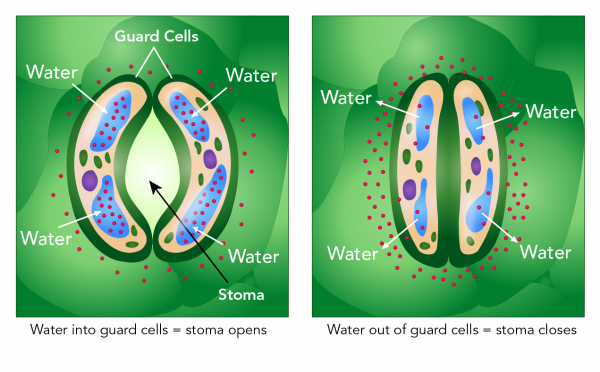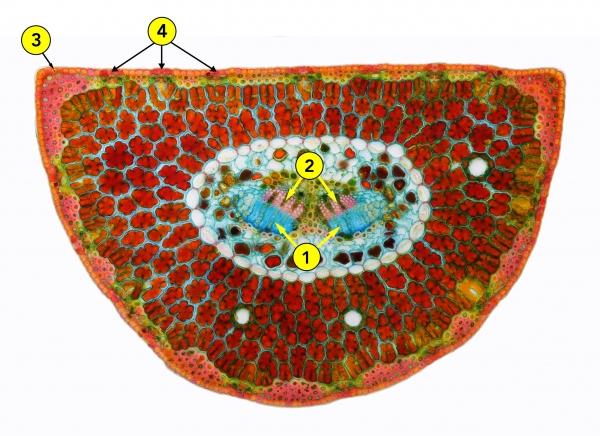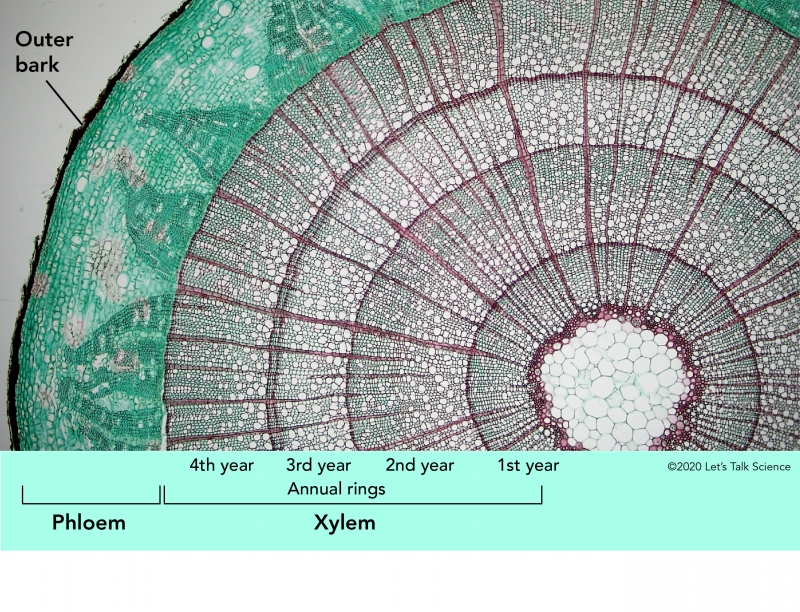what is a biome what adaptations allow evergreen trees to survive long cold winters
How Do Trees Survive in Wintertime?
Coniferous and deciduous trees covered in snowfall (Couleur, Pixabay)
How does this marshal with my curriculum?
When it's cold outside, you probably put on a hat and mittens to help keep yourself warm. However, trees can't practise this. Instead, trees accept a number ofadaptations that let them to survive during the winter.
Start of all, there are two master types of trees found in places with common cold climates, similar Canada. They are known equallydeciduous trees andconiferous trees. Deciduous trees lose their leaves in the winter. Coniferous trees typically do not lose their leaves in wintertime. Their leaves, oftentimes called "needles," stay on the trees twelvemonth circular. Because of this, they are ofttimes called "evergreens." Both types of copse are adapted to survive common cold temperatures. Some of these adaptations are the same and some are different.

Misconception Alert
The term "Coniferous" comes from the word cones, which is what nosotros call the reproductive parts of these plants. Some conifers lose their needles in autumn. Larch trees, whose needles turn golden yellowish, are an instance of this.
What adaptations practice copse have for common cold temperatures?
The tree's bark acts as its first line of defence confronting the cold. Theouter bark protects the tree from illness, insects, storms, and extreme temperatures. It is full of air spaces and works like insulation for the tree. It is similar to the insulation in the walls of your dwelling house.
Tree leaves likewise take adaptations for cold temperatures.
Theleavesof a tree are wherephotosynthesis takes place. This is the procedure in which plants use the free energy from sunlight to chemically combine carbon dioxide and water to form sugars. Trees and then utilise these sugars for energy.
The other important process that happens in leaves istranspiration. Leaves accept openings calledstomata(plural ofstoma). These openings are controlled byguard cells, which can open up and shut the stomata. During transpiration, oxygen gas and water vapour leave the tree from the stomata. Every bit water leaves the stomata, more water is pulled up from the roots through the xylem. This is why water can menstruum upwards in a tree!

During winter, tree roots cannot admission liquid water because the ground is frozen. So, to keep the leaves from wasting water through transpiration, deciduous copse lose their leaves in autumn. The technical term for losing leaves isabscission.
But what most coniferous trees? They practise not drop their needles. So how practice they survive the cold, dry out conditions of winter?
Coniferous trees accept different leafage adaptations.
- Their needles are long and thin. This means that they have a small surface surface area. Less surface area ways that they have fewer stomata from which to lose h2o. Narrow leaves likewise help keep snow from building up and breaking branches.
- Their stomata are not on the surface of the needle, but rather are deep within the needle. This creates a pocket of still air merely within the needle. Still air results in less transpiration than moving air.
- Their needles accept thick, waxycuticles. The cuticle is the outermost part of a leaf. The wax helps to forestall h2o loss. Think of how wax newspaper wrapped around nutrient keeps information technology from drying out.

How practise trees prepare for wintertime?
In the fall, trees brainstorm preparing fordormancy. They will remain in dormancy throughout the winter. During dormancy, a tree's metabolism, or internal processes, slow down. The tree doesn't swallow equally much energy, and it will stop growing. Past doing this, it tin can conserve energy to stay alive during the cold wintertime.
The tree volition also begin to change how it deals with water within its tissues.
Below a tree's bark are the tissues that motility h2o, saccharide and other nutrients up and down the tree. It is like the tree'due south plumbing organization. This arrangement contains two major types of transport tissues that act like pipelines: the phloem and the xylem. Thexylem moves water and nutrients upwards from the tree's roots to its leaves. Thephloem, on the other hand, moves sugars down from the tree's leaves to the residuum of its parts. The fluids that move upwardly and downwardly the tree are known every bitsap.

A lot of water moves up and down the tree through the xylem and phloem, and if this h2o freezes, information technology can destroy the tree's cells. This is because ice crystals are abrupt and can tear through cell walls. So, only similar at your home, it is of import that a tree's pipes do not have water in them that tin can freeze.
One mode that the tree works to prevent ice impairment is by controlling where ice forms. Ice has to form around something. Outdoors, this is normally things similar bits of dust. In plants, ice can form around sure types of molecules chosenice nucleators. Trees produce proteins that act as ice nucleators and send them in between cells.
As water ice begins to form, it draws liquid water out of the tree's cells. As more and more water is pulled out of the cells, the sap left inside the cells will incorporate more and more sugars. The sap becomes very thick and syrupy. It at present has a freezing point lower than the environment, and and so it is more than difficult to freeze.
In addition to the nucleators, trees also produceantifreeze proteins. These proteins aid prevent water ice crystals from forming in common cold temperatures.
Did you know?
Some types of trees -- such as sugar maples -- can exist tapped for their sap. After enough sap is collected, it is boiled down to create the maple syrup that people love to eat on pancakes and waffles!

And so now, with its water safely dealt with and its leaves taken intendance of, the tree is fix to settle down for a long wintertime's nap. When spring comes and temperatures begin to ascent in one case more, all of these processes will begin to contrary. This is when nosotros run across leaves starting to bud on trees and everything begins to grow again!
Connecting and Relating
- How do you arrange to the colder temperatures of wintertime?
- Accept you ever seen sap running from a tree in the bound? Describe what you saw.
- Exercise you like maple syrup? Why or why not?
Connecting and Relating
- How do you adapt to the colder temperatures of winter?
- Have you ever seen sap running from a tree in the spring? Describe what you saw.
- Do yous like maple syrup? Why or why not?
Relating Science and Technology to Social club and the Environment
- Should nosotros support research that would await for ways to grow plants from warmer climates in colder environments such as the Arctic? Why/why not?
- Research technologies that humans have created to help protect or grow plants in unfavorable growing conditions, such as during the wintertime.
Relating Science and Applied science to Society and the Environment
- Should we back up enquiry that would look for means to grow plants from warmer climates in colder environments such as the Arctic? Why/why not?
- Enquiry technologies that humans accept created to help protect or grow plants in unfavorable growing conditions, such as during the winter.
Exploring Concepts
- What adaptations exercise plants accept to assistance them survive in environments where the temperature drops below freezing? Explain.
- Are all plants able to survive winter temperatures? Why or why non?
- Practise all living organisms have "survival plans"? Hash out.
- What role does photosynthesis play in a tree's dormancy?
Exploring Concepts
- What adaptations do plants have to help them survive in environments where the temperature drops beneath freezing? Explain.
- Are all plants able to survive wintertime temperatures? Why or why not?
- Exercise all living organisms have "survival plans"? Discuss.
- What function does photosynthesis play in a tree's dormancy?
Didactics Suggestions
- This article and connecting resource, can be used to back up teaching and learning of biological science related to plant anatomy, constitute cells, plant processes and copse. Concepts introduced include adaptations, coniferous and deciduous trees, bawl, stomata, guard cells, abscission, leaf cuticle, dormany, xylem, phloem, ice nucleators and antifreeze proteins.
- This commodity tin as well be useful to assistance students deepen their understanding of the connections betwixt abiotic and biotic factors in the ecosystem.
- To innovate this topic, and activate students' prior knowledge, teachers could apply an Admit Slip Learning strategy. Fix-to-use reproducibles for this article are bachelor in [Google doc] and [PDF] formats.
- To consolidate their learning of winter adaptations by trees, students could use a Cardinal Ideas Round Robin Learning strategy. Prepare-to-employ reproducibles for this article are available in [Google doc] and [PDF] formats.
- Students could design an investigation to study how temperature affects the growth and development of different types of plants.
Pedagogy Suggestions
- This commodity and connecting resources, can be used to support teaching and learning of biological science related to institute anatomy, establish cells, plant processes and trees. Concepts introduced include adaptations, coniferous and deciduous trees, bawl, stomata, baby-sit cells, abscission, leaf cuticle, dormany, xylem, phloem, ice nucleators and antifreeze proteins.
- This commodity can likewise be useful to assistance students deepen their understanding of the connections between abiotic and biotic factors in the ecosystem.
- To introduce this topic, and activate students' prior knowledge, teachers could use an Admit Slip Learning strategy. Ready-to-use reproducibles for this article are available in [Google dr.] and [PDF] formats.
- To consolidate their learning of wintertime adaptations past trees, students could use a Key Ideas Round Robin Learning strategy. Gear up-to-use reproducibles for this article are available in [Google doc] and [PDF] formats.
- Students could pattern an investigation to study how temperature affects the growth and development of unlike types of plants.
Learn more
Upward Goes the Water (2004)
This commodity by Kathleen Damonte of the National Scientific discipline Teaching Association contains information well-nigh capillary action and a simple experiment to demonstrate how it works.
A tree in wintertime (2020)
What do trees do to get through the cold flavour? This article form Espace pour la vie Montréal explains how they start preparing in the month of August! Learn about how and when copse brainstorm preparing for wintertime.
How Practise Deciduous Trees Survive Winter? (2019)
This folio on brockleytree.com explains how copse prepare for wintertime as well as how people can help trees to survive.
References
Gupta, R., & Deswal, R. (2014). Antifreeze proteins enable plants to survive in freezing atmospheric condition. Periodical of Biosciences, 39(5), 931-934. DOI: 10.1007/s12038-014-9468-2
North Carolina Forestry Association. (due north.d.). Parts of a tree.
Permit'south Talk Science needs your input!
Our programs and resources are offered at no cost thanks to generous contributions from our supporters.
Please take a minute to tell us the name of your school/organization so we can better sympathise the bear on of our programs.
Open Survey
Source: https://letstalkscience.ca/educational-resources/stem-in-context/how-do-trees-survive-in-winter
0 Response to "what is a biome what adaptations allow evergreen trees to survive long cold winters"
Post a Comment